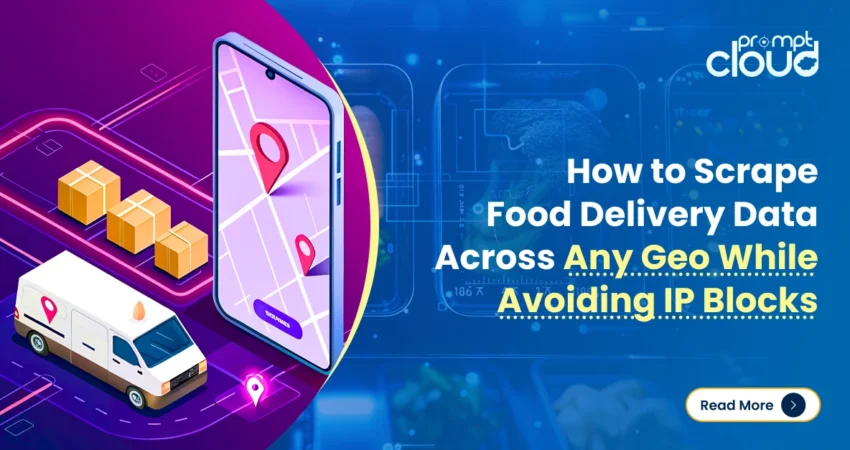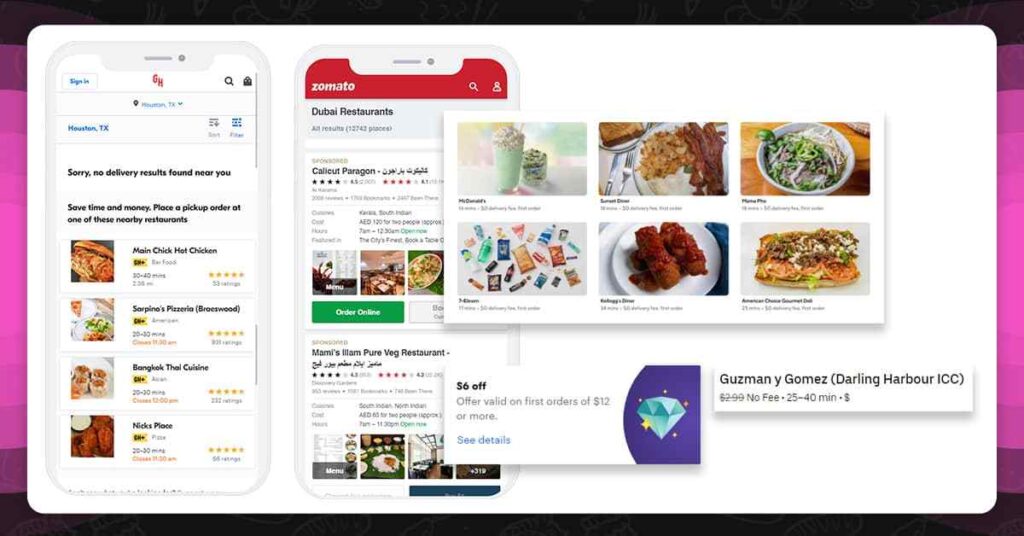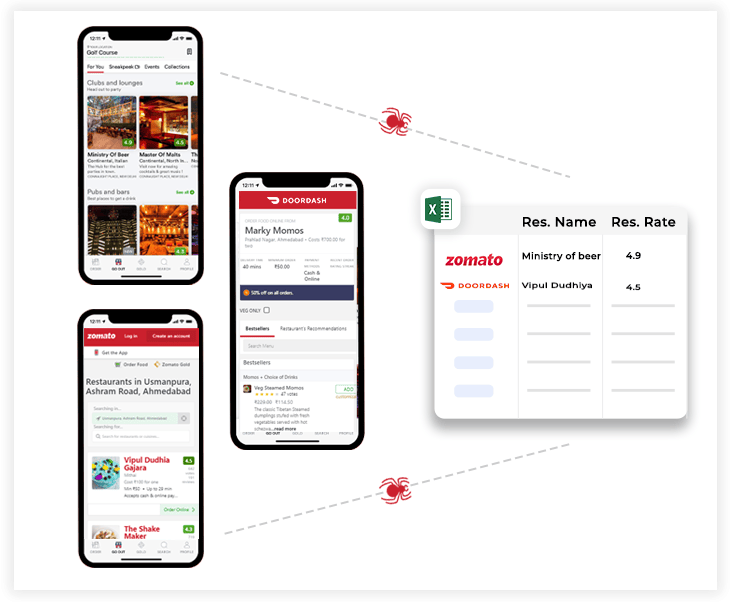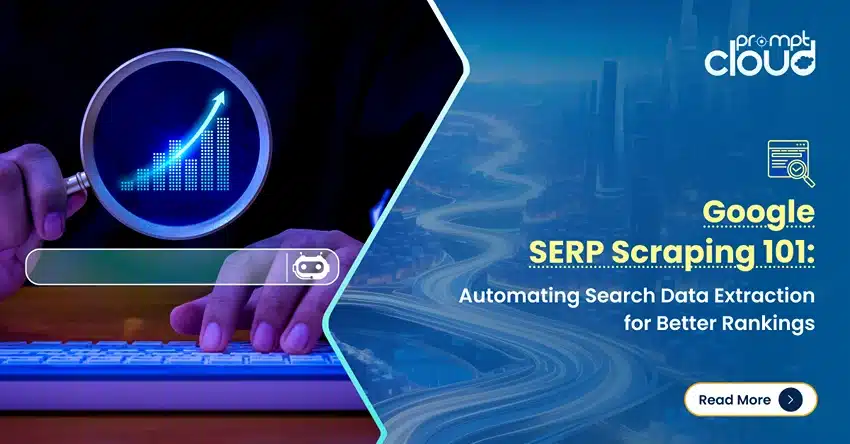
The delivery sector has expanded significantly in recent times. Nowadays, millions of people use Uber Eats and DoorDash in the United States; while in India, Zomato and Swiggy are popular choices as well. The food delivery market globally is expected to grow and reach $320 billion by 2029.
This growth is driven by ease of access, as well as an increase in the use of mobile apps. But for businesses, industry analysts, and stakeholders, keeping pace with this rapidly changing sector is significantly more complex than ordering a pizza. Food delivery app scraping is the solution.
Gathering data from food delivery apps can yield useful information regarding pricing, customer preferences, and competing businesses. However, obtaining this information is not as easy because of IP blocks and geo-restrictions.
In this article, we discuss the ins and outs of scraping data for food delivery apps and how to do it in a manner that protects against IP bans and geo-restriction bans.
Why Scrape Food Delivery App Data?

Image Source: XByte
Before getting into the step-by-step food delivery app scraping, it is important to first highlight why you would want to scrape this data.
• Competitive Intelligence:
Businesses can collect competitors’ menus, prices, promotions, and reviews by scraping data from food delivery apps. This helps businesses maintain an edge over the competition by changing their pricing or promoting strategies to match or better those of the competitors.
• Market Trends:
You can collect information about food trends such as seasonal popularity, average delivery time, or customer preferences using automated scraping. This knowledge is crucial when attempting to forecast market changes or interpret customer activity.
• Customer Sentiment Analysis:
Reviews and ratings come hand in hand with any food delivery app. With scraping, businesses can analyze customer sentiment by reviewing their comments, discover common grievances, and learn what needs to be improved.
• Service Optimization:
Scraping food delivery apps helps businesses analyze order distribution by region, average time taken for delivery, and customer service rating. This information enables businesses to streamline service processes and enhance their service delivery speeds.
With this data, businesses can make better-informed decisions and adjust their marketing strategies. As a result, customer satisfaction is bound to improve.
How to Scrape Food Delivery Mobile App Using Python?

Image Source: iWebScraping
Data scraping from mobile apps (Android or iOS) requires a different set of skills than traditional web scraping. With the advancement of technology, Python has emerged as a top candidate for these tasks due to its flexibility as well as extensive libraries. Here’s how you can scrape food delivery apps on both platforms for data:
Scraping Android Apps
Android apps are comparatively simple to scrape because APK (Android Package) files are readily available. The process is as follows:
- Download APK: You can get the APK file of the food delivery app you wish to scrape using tools like APK Extractor.
- Decompile the APK: After obtaining the source code, you can use Jadx or Apktool to decompile it. This helps in figuring out the API endpoints utilized by the app.
- Intercept APIs: Mitmproxy or Fiddler can be used for intercepting as well as investigating the network requests employed by the app, helping in understanding how the app functions with its server.
- Scraping the data with Python: After using the methods above to understand how the APIs function, the final stage gently concerns sending a request to extract the data using Python. Utilize libraries such as requests or httpx to perform a GET request to the endpoints.
Scraping iOS Apps
Apple’s heightened security systems make scraping iOS apps more complicated, however, with the right resources it is still possible. Essentially, the primary components involved are:
- Proxy Setup: Charles Proxy or Burp Suite can be used to keep track of the network traffic from the iOS app.
- HTTPS Traffic Decryption: To decrypt the traffic for iOS apps, you need to install an SSL certificate on your device since HTTPS encryption is usually used.
- API Endpoint Identification: Examine the network traffic to determine the API endpoints that the app employs.
- Data Extraction with Python: Just like Android, Python libraries can be used to make an extract to the API endpoints and the data can then be extracted.
These techniques, while useful and effective in their regard, both require a solid grasp of network protocols and API scaffolding. If you are not familiar with these concepts, you may want to work with a web scraping service.
What are the Benefits of Scraping Food Delivery Apps?
There are numerous advantages to food delivery app scraping, particularly for firms aiming to remain agile in the market:

• Access Real-Time Data:
Scraping provides access to real-time data that includes menu items, their prices, and delivery timelines. Having up-to-the-minute information allows businesses to be proactive and develop strategies that will keep them in the game.
• Competitor Benchmarking:
Data scraping from food delivery apps enables analysis of opponents for their menus, customer satisfaction ratings, and prices allowing the business to have a clear picture of their and the competitors’ current standings.
• Understanding Customers Better:
Understanding customers’ likes, dislikes, and trends is made easier by scraping insights from food delivery apps. With such information, organizations can form strategies that would maximize customer satisfaction.
• Increased Efficiency:
The gathered data can be utilized to identify areas that, when implemented, will bring about improvement in productivity or operational efficiency. This could include popularizing famous dishes on the menu or planning better routes for deliveries.
Common Challenges in Food Delivery App Scraping
Scraping food delivery apps is not without its challenges. Some of the common hurdles include:
- IP Blocking: Food delivery apps such as Uber Eats are known to restrict access to IP addresses for users who make multiple requests within a short span of time. This is mostly the case when automated scraping is suspected.
- Captcha Protection: A lot of food delivery apps have been implementing Captcha systems so that only humans can access their information, instead of automated website scrapers referred to as bots.
- App Security Measures: Security measures such as encryption and obfuscation to prevent scraping are present in both Android and iOS apps.
- Dynamic Content: Most modern food delivery apps use JavaScript to dynamically load content, meaning that one cannot simply scrape data, but rather has to extract it from the dynamically generated HTML.
- Legal Risks: Some apps make sure to include legal terms of service that prevent scraping. Providing legal obligations for applying a scraping algorithm becomes complex and intricate.
Overcoming these challenges is key to successful scraping, and we’ll dive into specific techniques next.
Techniques For Food Delivery App Scraping While Avoiding IP Blocks
IP blocking is a common problem when conducting food delivery app scraping. However, there are several ways to get around these restrictions:
• Use Proxies
Using rotating proxies is one of the most effective ways to defeat IP blocks. By using a large number of IPs, it becomes easier to share requests in different locations. It is harder for the website to identify your scraping attempts.
• Implementing User-Agent Rotation
The string that is sent with the request provides information on the device or browser that is making use of it. For food delivery apps, this string can be used to identify scraping attempts.
Scraping can be disguised by rotating user-agent strings that would make it seem as if multiple users were using the app on different devices or browsers.
• Set Up Scraping Schedules
You can set aside specific timeframes to carry out automated scraping instead of submitting a lot of requests over a small timeframe. Distributing scraping requests minimizes rate-limiting or detection risks, which tends to happen with automated systems if requests are submitted too frequently.
• Use Captcha Solvers
Use Captcha-solving services for apps that include Captchas for food delivery. These services employ AI or remote human workers that can eliminate Captchas instantly, ensuring your bot can run without interruptions.
• Scrape Data During Off-Peak Hours
When there is less traffic, such as in the late night or early morning hours, is the best time to schedule scraping tasks if you want to remain undetected.
Use Case: Scraping Food Delivery Data Across Multiple Geos
Let’s say you operate a competitor intelligence service for a global food delivery company. There’s a need to gather information on pricing and promotional offers in different cities across the globe. By managing geo-targeting and IPs, you can access food delivery data in the US, Europe, and Asia. This will prevent you from being blocked.
By using a proxy server in different countries, you can make it look like your requests are coming from different locations, which allows you to gather pricing data, menu items, delivery charges, and promotions. This is helpful to understand local competition, preferences, and customer needs in addition to your services.
Specialized web scraping tools can gather data from multiple food delivery applications simultaneously. This makes it easy to analyze the international food delivery sector.
Conclusion
Food delivery app scraping is effective when it comes to understanding competition and other important factors. However, the risk of IP block is a significant issue. For those looking to bypass this problem, rotating your proxies, rate lowering, and API scraping enable obtaining information without getting blocked.
If you’re part of a food delivery company, competitor intelligence group, or a web scraping company, learning how to scrape data off food delivery apps can be beneficial for your business. This is an emerging industry, so you want to use all the tools in your arsenal. Now is the time to get started!If you’re looking for a food delivery mobile app data scraping service, you have come to the right place. PromptCloud can provide web scraping services to fit your needs. Let’s have a conversation about how we might assist you. Let’s connect and discuss how we can help you.


















